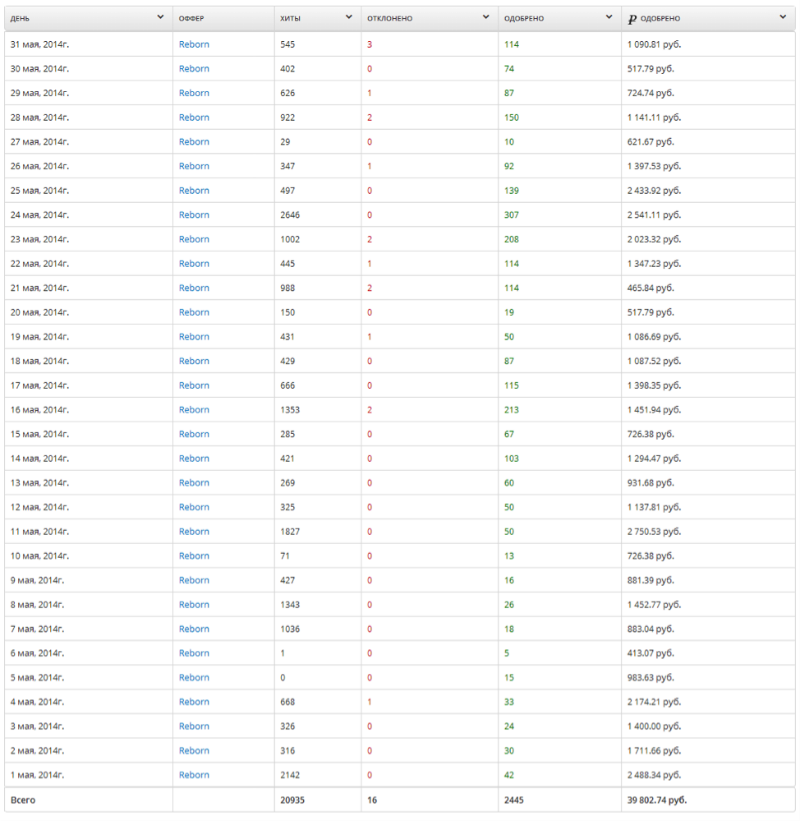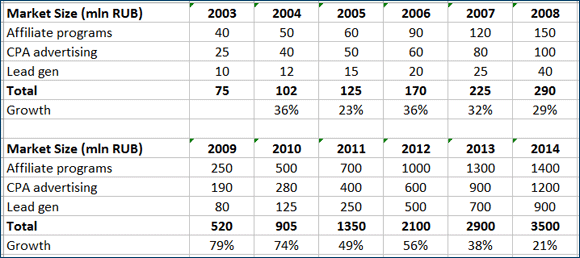How Internet advertising works: Traffic arbitration

Cost Per Action is an advertising model in which the advertiser pays for only certain actions performed by the user on his site (click, register, subscribe to the newsletter, purchase), and not abstract displays of their ads. During the active dissemination of this payment scheme for advertising on the Internet, it was believed that it would allow companies to optimize costs and receive the greatest return on advertising.
However, life has made its own adjustments, and not only advertisers get the real benefit from the CPA-model, but the advertising ecosystem itself has become very complicated.
')
What is CPA and who is this model for?
In the West, the term CPA is often referred to as cost per acquisition (“pay per acquisition”), because for online stores, which are the main advertisers for this model, it is important to make a sale. In Russia, this understanding of the term did not stick and the term CPS (Cost Per Sale) is used to designate a model implying payment for real sales.
One type of CPA is the direction of lead generation (CPL - cost per lead), in which the main task is to collect contact and demographic data of users - this is how their identity is known, while with classic CPA, targeted actions can be carried out by anonymous users.
First of all, the payment model for actions is suitable for companies that sell real goods or organizations that mainly promote their services on the Internet. Among such companies, CPA advertising is most often used by online stores, banks, travel companies and online games, hosting providers, airline and hotel booking services and representatives of offline businesses (lawyers, car services, construction companies, etc.) also resort to this model. .P.).
Story
Affiliate marketing (affiliate marketing), involving the creation of affiliate programs, was distributed even before the advent of the Internet. With the development of the network, a large number of affiliate programs operating under different schemes have appeared. Initially, they completely copied offline the organization of similar programs (on the advertiser's site were placed the forms in which it was necessary to enter the site or the person who facilitated the visit to the target resource). Later, the mechanism was improved - the notion of referral links (and even later - the cookie) appeared, which made it easier to track visitors.
Then there was a shift towards the automation of processes - if at the first stage the advertiser had to develop and install the software of the affiliate program on his website, then later ad networks appeared (mainly those that placed banners) that united a significant number of websites that just needed to be connected .
In particular, there are CPA-affiliate programs ("affiliate programs"), which consist in the fact that the advertiser shifts some of the concern for attracting clients on the shoulders of webmaster partners — site owners get affiliate links or banners, “lead” potential clients to the target site, and then receive the money if these users take the agreed actions.
In order to secure a profit, the webmaster should take care of the quality of traffic, and not just strive to "pour" it as much as possible.
Main Cons CPA
Theoretically, with the pluses of the CPA-model, everything is clear - this is transparency (the advertiser knows what he is paying for), savings (payment only for business-critical actions) and quality of traffic (“left” visitors do not take the necessary actions). In practice, the CPA model has a number of drawbacks.
Firstly, CPA does not take into account the quality of the audience - despite the fact that this model allows you to attract users who perform certain actions (that is, it is not quite “junk” traffic), conversion can be carried out only once (this is possible with discounts for they are pecked by “freelovers”).
In addition, the CPA-model does not work well in conditions of price elasticity - the cost of advertising resources may vary depending on time (for example, during the holiday period, advertising of many products becomes more expensive, because people buy more and the competition of stores increases).
CPA refers to a rigid advertising model and takes into account only the factor of the desired actions. As a result, advertisers do not increase advertising costs at those times when it is worth it, as traffic quality rises.
Some experts conducted experiments and found out that advertisers using the CPA model get poor results during the holiday periods — the graph below shows the return on advertising of an online store using the CPA model during Thanksgiving Day in the USA. The company did not increase costs, resulting in a sharp decrease in the number of registrations.

This experiment illustrates the fact that the CPA model does not take into account an important factor in the value of a particular customer — not all users who have committed a targeted action are equally important to business. From this point of view, the distribution of advertising costs in terms of potential returns at a particular point in time, looks like a more efficient approach.
Monetizing traffic through CPA
Paying for actions implies higher prices for advertising than using other means of attracting traffic than some webmasters began to use - they are called arbitragers.
To implement an arbitration strategy in a CPA-affiliate program, webmasters use low-cost traffic from authorized sources (often prohibit people from catching up through mailings, from adult sites and through contextual advertising) - if these users subsequently perform targeted actions, then payments webmaster block the cost of attracting traffic and allow him to get a plus.
Here is an example of such an arbitration strategy, which was described by the blogger under the nickname Wildo, who writes about market insiders. Attract traffic is necessary for the game Reborn (MMORPG genre), while partnership conditions are as follows - users must be from CIS countries, registration fees in the game are 0 rubles, the webmaster receives 52 rubles for an active player, and for the second attracted active player already 103 rubles.
For the very fact of registration they do not pay anything, so there is no simple “traffic surge” here. Among the prohibited sources of traffic did not appear on the social network, so Wildo attracted him there, buying advertising. In total, about 25 thousand rubles were spent on this (29 thousand minus a discount in the agent’s VK office):

By redirecting this traffic to the advertiser's site, the arbragger managed to attract more than 2,440 active players, for which, according to the rules of the system, he was charged more than 39 thousand rubles:

The net profit of the arbitration strategy was more than 14 thousand rubles. A similar affiliate program of the game Neverwinter also allowed the arbitrator to get a good profit on the difference in the cost of attracted and sold traffic.
You can monetize absolutely any traffic - in the same blog an example is given of the My Account business affiliate program, thanks to which webmasters could earn 150 rubles for “high-quality” registration and 1,500 rubles for purchasing a service (the amount increased to 2500 rubles. purchase within a specified period of time). The approach of referral marketing was also used there - the webmaster received 500 rubles for each new client brought in by attracting a new active participant in the program.
As you can see, arbitrage strategies can bring a lot of income - webmasters who are engaged in this craft often even hire designers who help them prepare advertisements.
There are quite a few people willing to learn the skills of arbitration - such courses are very popular and cost a lot of money.
Risks
The number of CPA-affiliate programs is quite large, new ones appear almost daily, and working with them often carries with it certain risks for the webmaster.
The cost of entry into the business of CPA networks in the past few years has decreased and now you can launch your network without having a significant start-up capital, while attracting webmasters often with promises of high payouts. However, the network itself receives money from the advertiser only after they receive the desired actions (for example, in the niche of postage goods they pay for the confirmed application, and not for the paid order).
In turn, webmasters are waiting for payment for their work immediately after they have brought quality traffic - as a result, ad networks have to pay them out of their money, and then replenish money by paying advertisers. Often, such a cash gap leads to the impossibility of fulfilling obligations in full, so webmasters should work with proven networks.
Civilized market
In the early days of the formation of the CPA-affiliate programs market, fraud was common when webmasters deceived advertisers (and their analytics systems) by selling them “black” traffic.

Among the methods used by advertisers to cheat are proxy servers, which allow users to assign fake data, replace the address of the site from which the user came from, cookie-dropping and cookie-cracking getting the right traffic) or using motivated traffic.
Over time, the main analytical software packages have learned to resist attempts to deceive, and the market has taken a big step towards its “whitewash”. Now the volume of the Russian market of CPA advertising is estimated at 3.5 billion rubles a year.

As an anonymous traffic seller said in an interview published on Habré, in the field of mobile CPA there is a common situation when advertisers sell “black” traffic - for example, motivated installation of applications, when users are offered bonuses or little money for downloading.
Motivated installation can be bought at 20 cents and sell for $ 2.
It can be assumed that with the development of the entire mobile advertising market, “black” and “gray” will become a thing of the past and most webmasters will work “white”, as in the case of CPA on the web.
What will happen to the CPA
CPA-model is still not so common in the field of serious business - for example, in the field of e-commerce. Not so long ago, representatives of Yandex reported that the growth in the use of this model in Yandex.Market is slower than expected.
Despite the presence of some drawbacks, the CPA-payment model has significant advantages - with its help advertisers manage to attract target users and save advertising budgets, in addition, this scheme is well suited for increasing brand awareness (awareness).
All this will lead to the fact that in the future CPA advertising will be used not only by businesses operating in the entertainment or gaming industry, but also by quite serious companies that are used to working with traditional means like “context” - CPA will become another advertising tool along with RTB -advertising
Source: https://habr.com/ru/post/242791/
All Articles